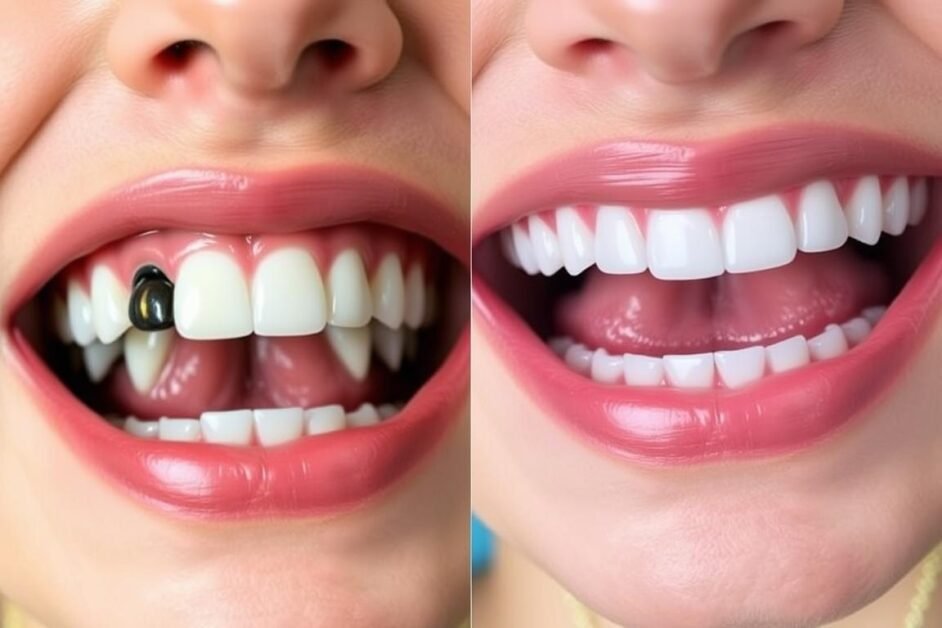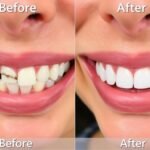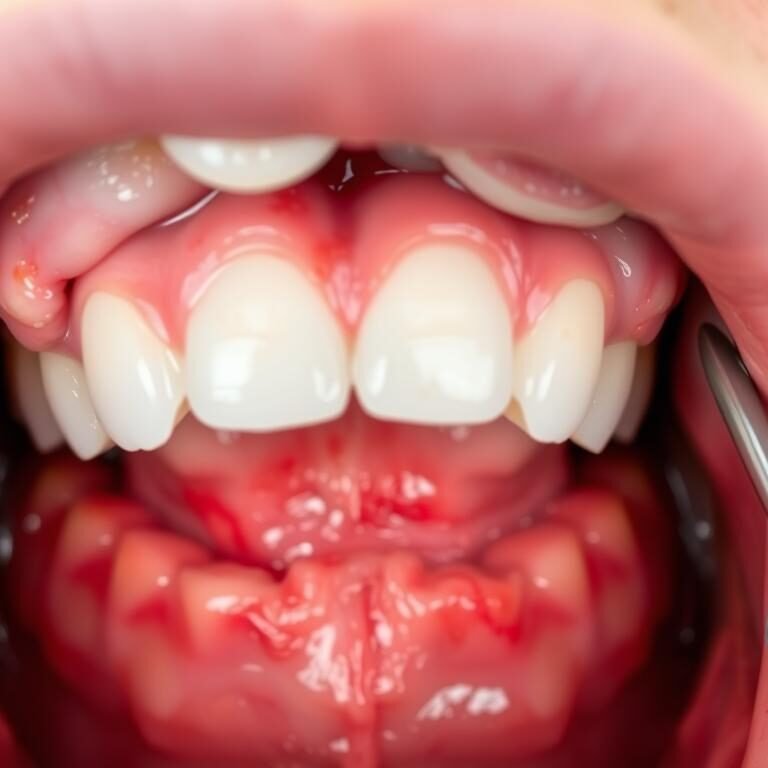Imagine looking in the mirror and feeling confident about your smile. Dental implants can make this dream come true. They change more than just how you look; they change how you feel about yourself.
Before and after photos show the amazing difference dental implants can make. They show how these implants can improve your life. These pictures tell stories of hope and healing, showing how dental implants can make your smile shine again.
What Are Dental Implants?
Dental implants are artificial tooth roots that replace missing teeth. They are strong metal posts that hold fixed or removable teeth in place. These teeth are called crowns or prostheses.
The implant is placed in the jawbone during surgery. It then fuses with the bone, a process called osseointegration. This fusion takes 3 to 6 months, but healing times can vary.
Dental implants are very versatile. They can replace one tooth or many. About 97% of them work well after five years.
Bone health is key for dental implants. Sometimes, bone grafting is needed to support the jawbone. This is true in about 20% of cases. With good care, implants can last a lifetime.
Knowing about dental implants is important if you’re thinking about them. They not only fill in gaps but also help keep the jawbone healthy. This makes them a great choice for tooth loss.
Benefits of Dental Implants
Dental implants do more than just replace teeth. They give a natural look that boosts your smile and confidence. Unlike dentures, implants are stable, so you can eat your favorite foods without worry.
Implants help keep your jawbone strong, which is key after tooth loss. Without teeth, the jawbone can shrink, making you look older. Studies show that without replacements, you can lose up to 30% of your jawbone in six months. Implants keep your jawbone healthy, keeping you looking young.
Implants are also easy to care for. They need only regular brushing and flossing. Patients are very happy with their implants, saying they look and feel great. They can speak and chew better, making socializing easier.
Implants are also very durable, lasting over a decade with a success rate of 97%. They can greatly improve your self-esteem and happiness. For more details, check out this dental implant information page.
Understanding the Dental Implant Procedure
The dental implant procedure is a detailed process with several steps. Each step is designed to ensure the best results for those looking to restore their teeth. First, patients go through assessments and imaging to find the best plan for them.
The next step is the surgical placement. Here, a titanium screw is placed in the jawbone, acting as a new tooth root. This starts the osseointegration process, where the implant fuses with the jawbone. This process takes 3 to 6 months and is key to the implant’s long-term success.

After healing, the abutment is attached. This is a small connector on top of the implant. Then, there’s a short healing period of about two weeks before the final crown is put on. This careful process ensures a secure and functional tooth replacement that fits each patient’s needs.
| Step | Description | Duration |
|---|---|---|
| Consultation & Imaging | Assessment of individual needs and treatment planning. | Varies |
| Surgical Placement | Embedding the titanium screw into the jawbone. | Immediate |
| Osseointegration | Fusion of the implant with the jawbone. | 3 to 6 months |
| Abutment Placement | Attaching the connector to the implant. | Immediate |
| Crown Placement | Final restoration placed on the abutment. | After 2 weeks |
Understanding each step of the dental implant procedure is key for patients. Working with experienced professionals ensures the treatment meets individual needs. This leads to a successful outcome and long-term satisfaction with the tooth restoration.
Before and After Dental Implants
Dental implants do more than just make your smile better. They change your life, making eating and talking easier. This section will show you how much of a difference they can make. You’ll see amazing dental implant before and after photos that prove it.
Transformational Changes in Smile and Function
Going from no teeth to a full smile can change your life. People say they feel more confident after getting implants. They can chew better, which means they can eat more kinds of food.
Visual Proof Through Before and After Photos
Photos tell the best story about dental implants. The dental implant before and after photos show big changes. They prove that implants can change your life, making you look and feel better.
| Before Treatment | After Treatment |
|---|---|
| Missing teeth in the upper front row | Beautifully restored smile with dental implants |
| Difficulty chewing and speaking clearly | Improved biting force and speech clarity |
| Low confidence in social situations | High confidence and improved social interactions |
| Limited dietary options | Ability to enjoy varied and healthy foods |
Common Reasons for Tooth Loss
Tooth loss affects about 120 million people in the United States. Many face dental conditions that cause this issue. Knowing the reasons for tooth loss helps prevent and treat it. Tooth decay is a big reason, caused by bad oral hygiene and missing dental visits.
Gum disease, a result of untreated tooth decay, is the top cause of tooth loss in adults. Age also matters, with over 26% of adults aged 65 and older having few teeth. About 17% of those in this age group have lost all their teeth.
Smoking greatly increases tooth loss risk. Smokers are more than twice as likely to lose all their teeth compared to nonsmokers. Systemic diseases like Type 2 Diabetes, Hypertension, and Osteoporosis also raise the risk due to their impact on oral health.
Traumatic injuries, like those from sports or accidents, can cause tooth loss right away. Knowing about these risks shows why good dental hygiene and regular check-ups are key. For those with existing conditions, addressing them can greatly improve oral health. Resources like this article on maintaining tough teeth offer helpful tips to prevent tooth decay and its effects.
Patient Success Stories: Dental Implant Transformations
Dental implants have changed lives for many, offering a solid fix for missing teeth. Countless stories show how implants have not just fixed teeth but also boosted confidence and looks. These stories are real-life makeovers, showing how implants have brought back smiles and hope.
Real-life Examples of Dental Implant Makeovers
Millions in the U.S. lose teeth, making implants key for better smiles and life quality. They offer comfort and stability, often better than dentures. People can eat their favorite foods and talk without worrying about their teeth moving.
These changes also boost self-esteem. Studies show up to 90% of people feel more confident after getting implants.
Every story is unique, with its own challenges and victories. For those over 50, implants help keep the jawbone strong and fight aging signs like sunken cheeks. Experts tailor each experience, leading to high patient satisfaction. Dr. Gary Ashton is known for his work in cosmetic dentistry, changing lives.
Statistics show dental implants are highly effective. About 70% of patients would recommend them, and 75% say their life quality improved, including in social situations. These stories prove implants are the best choice for replacing teeth.
More people are looking into dental implants, inspired by these success stories. With a 95% success rate over ten years, implants offer a strong, stable base for a confident future. Considering dental implants can lead to amazing improvements in both function and self-image.
The Dental Implant Recovery Process
The dental implant recovery process is key for the procedure’s long-term success. Patients may feel mild pain and swelling after surgery. These symptoms usually get better each day.
The first 24 hours are very important. Post-operative care is crucial to prevent infection and ensure healing. Cold compresses can help with pain and swelling. Also, eating soft foods is recommended starting one hour after surgery.
The healing time can last up to eight months. During this time, patients should avoid hard activities and smoking or alcohol for a week. If bone grafts are needed, recovery can take longer, sometimes up to 9 months.
It’s important to watch for signs of complications. A fever over 101.5°F in the first 24 hours could mean an infection. This needs immediate medical attention.
Keeping in touch with your dentist is important during recovery. Tell your dentist about all medications you’re taking. This is because some pain relievers can interact with other drugs. Following these tips can make your recovery smoother. For more on managing pain, check out pain after tooth extraction.
Dental Implant Progress Timeline
The dental implant progress timeline is key for setting patient expectations during recovery. Knowing the healing phases helps individuals prepare for what’s ahead. The journey starts right after the implant is placed and takes several months. Let’s look at what to expect in the first month.
What to Expect in the First Month
In the first month after surgery, the main focus is on healing. Patients might feel some pain, swelling, or bruising. It’s important to follow the aftercare instructions given by the dentist to help with healing.
- Week 1: Follow-up appointment to check on healing and manage any pain.
- Week 2: Keep watching the healing site and might need to adjust care routines.
- Week 4: Check if the implant site is integrating with the bone properly.
Patients usually have follow-up appointments at 1 week, 2 weeks, and then at 1 month. These visits help monitor progress and ensure healing is on track. For cases needing bone grafts, an extra 4 months might be needed before placing the implant.
In this first month, patients learn about osseointegration. This is when the implant fuses to the jawbone. It can take 3 to 6 months for the lower jaw and up to 7 months for the upper jaw. Knowing this timeline helps set realistic expectations for recovery.
Understanding the dental implant progress timeline is crucial. It prepares patients for each stage of their journey. This knowledge makes the recovery process smoother and leads to a restored smile and better oral health. For more on dental preparation, visit this link.
| Phase | Duration | Details |
|---|---|---|
| Initial Healing | 1 month | Follow-up and assessment appointments |
| Osseointegration | 3 to 7 months | Integration with jawbone |
| Abutment Placement | 10-14 days post-crown fabrication | Final impressions taken for the crown |
| Permanent Crown | Varies by case | Final restoration completed |
Full Mouth Restorations with Dental Implants
Full mouth restorations are a big step in dental care for those who have lost many teeth. They use dental implants for a look and feel that’s close to real teeth. Unlike dentures, implants don’t move around and cause discomfort.
For full mouth restorations, up to 8 implants might be needed. This is for people with missing teeth or teeth that don’t look right. Specialists like Dr. Perry make sure the teeth work perfectly and look great.
Getting complete restorations does more than just fix your teeth’s look. It also tackles problems like gum disease and old, failing dental work. The treatment might include braces and surgery to make sure your new teeth feel and look right.
- Improved aesthetic outcomes that last a lifetime
- Support for fixed prostheses eliminating the discomfort of traditional dentures
- Restoration of functionality for daily activities like eating and speaking
Many patients are very happy with their new teeth. They say it’s a big improvement over old crowns and dentures. Implant dentistry can fix many problems, giving patients the smile they’ve always wanted.
| Dental Condition | Treatment Approach | Expected Outcome |
|---|---|---|
| Complete tooth loss | Full mouth restoration with implants | Stable, functional, and aesthetic teeth |
| Chronic gum disease | Immediate implants and fixed prostheses | Improved oral health and comfort |
| Congenital tooth loss | Placement of multiple implants | Replacement of missing teeth |
| Failing restorations | Replacement with new implant-supported crowns | Enhanced functionality and aesthetics |
Single Tooth Replacement Results: Before and After
Looking into single tooth replacement shows amazing changes with dental implants. A detailed study shows a patient’s journey from a broken tooth to a full smile. The before and after photos show how one implant can change a person’s smile and life.
Case Study: Replacing a Broken Tooth
A 40-year-old man had a broken molar removed and then got a bone graft. He then had a guided implant placed. This shows how modern dental implants work fast and well.
The patient got a guided implant surgery. This method placed the implant without harming nearby teeth. It helped him heal quickly and got him a tooth that looked and worked great.
Before the surgery, the patient had trouble eating and felt bad about his smile. After the implant, he could eat better and felt more confident. The before and after photos show how much his life improved.
| Phase | Details |
|---|---|
| Initial Consultation | Assessment of broken tooth and bone structure |
| Tooth Extraction | Removal of fractured molar |
| Bone Grafting | Preparation of site for implant placement |
| Implant Placement | Guided technique ensuring precision |
| Recovery Time | Typically 3 to 6 months for osseointegration |
| Final Restoration | Completion of crown placement for full function |
These dental implant stories show how far dental tech has come. They not only make smiles better but also change lives. For more on dental options, like adult braces, check out this article.
Understanding Implant Failures and Solutions
Dental implant failures can happen for many reasons. It’s key for patients to know the risks. Early failures often come from bad bone quality or diseases. Diabetes can also increase the risk of implant rejection.
Later failures, within one to three years, might be due to too much stress on the implant or peri-implantitis. This is a big problem that causes inflammation and infection.
Peri-implantitis can cause serious bone loss if not treated. This can make the implant unstable. It’s important to watch for signs like mobility or bone loss on X-rays.
Going to the dentist regularly helps catch problems early. This can lead to better outcomes.
Problems like screw loosening can happen more often. This goes from 4.3% in five years to 26.4% in ten years. Cemented restorations can also lose retention, happening in 6.2% in five years and 24.9% in ten years.
Using advanced methods like 3D-printed guides can help. These methods improve precision and lower failure risks.
Before getting dental implants, it’s important to check your health. This includes conditions like osteoporosis or heart problems. Following post-op care and making lifestyle changes, like quitting smoking, can greatly improve success rates.
Success rates for dental implants can be as high as 98% under the right conditions. For those who have failed, there are solutions. These include removing the implant, using bone regeneration, or a staged approach to rebuild tissue before trying again.
By understanding these factors and exploring proven solutions, patients can aim for successful dental implant outcomes. Learn more about dental implants here.
Factors Influencing Dental Implant Success Rates
Knowing what affects dental implant success is key. Things like the dentist’s experience, how well you take care of your teeth, and your health matter a lot. Choosing a skilled dentist is crucial because their expertise greatly affects the success of the implant.
Importance of Choosing an Experienced Dental Professional
An experienced dentist is very important for dental implant success. Studies show that using guided surgery techniques leads to better results. This approach is less risky and causes fewer problems than older methods.
Several important factors affect dental implant success:
- Age of the Patient: Younger people, under 40, have success rates up to 95%. Older adults see rates around 85%.
- Bone Density: Thicker bones make it more likely for the implant to work well.
- Health Conditions: Health issues like diabetes can make success harder, affecting about 30% of patients.
- Oral Hygiene: Regular dental visits and good oral care help implants last longer.
- Experience of the Dentist: A skilled dentist can place implants more accurately, improving success rates.
- Smoking: Smokers have much lower success rates because smoking reduces blood flow.
Choosing a dentist with a good reputation can lead to better results. Using the latest imaging and placement techniques can boost success by up to 15%. Following post-surgery care can also increase success by 5-10%. So, picking the right dentist is crucial for the best dental implant outcomes.
Aftercare and Maintenance of Dental Implants
Proper care of dental implants is key to their long life and good function. Patients need to follow tips for healing, avoiding problems, and keeping their mouth healthy. Simple steps can help with recovery and keep the implants working well for a long time.
Daily Care Tips for Long-lasting Results
After getting an implant, it’s important to keep your mouth clean. Here are some important tips:
- Follow prescribed medication: Pain and discomfort are common after surgery. Taking your medicine as told will help manage these feelings.
- Soft food diet: Eat soft foods for the first 4 weeks. Avoid hard or chewy foods that can harm the implants.
- Oral hygiene: Start brushing gently 2 to 3 times a day from day 2. Flossing every day and using a Waterpik is good after 12 weeks.
- Gentle rinsing: Use a warm saltwater solution to rinse your mouth from the day after surgery. This helps healing without disturbing the implant site.
- Regular dental check-ups: See your dentist at least once a year for check-ups and maintenance.
- Manage swelling: Use a cool pack for the first 48 hours to reduce swelling and bruising.
- Smoking cessation: Stop smoking for at least 2 weeks after the implant to help healing.
- Massage mucosa: Massage the area around the implant weekly to reduce bacteria buildup.
Following these tips is crucial for dental implant care. Stay focused on your oral hygiene and talk to your dentist regularly. This will help keep your implants working well for a long time and avoid problems.
| Care Tips | Frequency | Notes |
|---|---|---|
| Brush Teeth | 2-3 times a day | Start on day 2 after surgery |
| Floss | Daily | After day 14 |
| Warm Saltwater Rinse | Daily | Starting day after surgery |
| Soft Food Diet | First 4 weeks | Avoid hard or chewy foods |
| Dental Check-ups | At least once a year | For maintenance and assessments |
Contact Us for a Consult on Your Dental Implant Journey
Thinking about dental implants? A personalized consultation is key. At Sharp Dentistry & Associates, we offer expert advice for your needs. We guide you from the start of your dental journey.
Our team knows each patient is unique. We create treatment plans that fit your situation. With advanced tech like digital X-rays, we ensure your implants are safe and effective.
Got questions about dental implants? Our free consultations can help. By choosing us, you’re not just getting treatment. You’re joining a team dedicated to your health and happiness. Contact us today to begin your journey to a healthier smile!
FAQ
What are dental implants and how do they work?
Dental implants are artificial tooth roots. They provide a stable base for new teeth. The implant, abutment, and crown work together for permanent teeth.
What are the benefits of getting dental implants?
Dental implants look and feel natural. They last long and improve how you eat and speak. They also boost your confidence.
How long does the dental implant procedure take?
Getting dental implants takes several steps. This includes consultations, imaging, and surgery. The whole process can take months to a year, depending on your case.
What can I expect during dental implant recovery?
After getting implants, you might feel some pain and swelling. Follow your dentist’s care instructions to heal well.
Are dental implants suitable for everyone?
Most people with missing teeth can get implants. You need enough bone and good health. Talk to a dentist to see if you’re a good candidate.
What factors can affect the success of dental implants?
Success depends on your dentist’s skill, your health, and how well you care for your teeth. A skilled dentist is key for good results.
How long do dental implants last?
With the right care, implants can last a lifetime. Regular dental visits and good oral hygiene are crucial.
What are some common reasons for tooth loss?
Tooth loss often comes from decay, gum disease, injury, or birth defects. Knowing these causes helps prevent tooth loss and treat issues early.
How do dental implants improve the quality of life?
Implants make your smile look and feel real again. They help you eat and speak better. This boosts your self-esteem and overall happiness.
What aftercare is necessary for dental implants?
Caring for implants means brushing and flossing right, visiting your dentist regularly, and avoiding hard foods. This keeps your implants strong.











